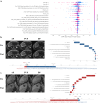Longitudinal CE-MRI-based Siamese network with machine learning to predict tumor response in HCC after DEB-TACE
- PMID: 40830494
- PMCID: PMC12366127
- DOI: 10.1186/s40644-025-00926-5
Longitudinal CE-MRI-based Siamese network with machine learning to predict tumor response in HCC after DEB-TACE
Abstract
Background: Accurate prediction of tumor response after drug-eluting beads transarterial chemoembolization (DEB-TACE) remains challenging in hepatocellular carcinoma (HCC), given tumor heterogeneity and dynamic changes over time. Existing prediction models based on single timepoint imaging do not capture dynamic treatment-induced changes. This study aims to develop and validate a predictive model that integrates deep learning and machine learning algorithms on longitudinal contrast-enhanced MRI (CE-MRI) to predict treatment response in HCC patients undergoing DEB-TACE.
Methods: This retrospective study included 202 HCC patients treated with DEB-TACE from 2004 to 2023, divided into a training cohort (n = 141) and validation cohort (n = 61). Radiomics and deep learning features were extracted from standardized longitudinal CE-MRI to capture dynamic tumor changes. Feature selection involved correlation analysis, minimum redundancy maximum relevance, and least absolute shrinkage and selection operator regression. The patients were categorized into two groups: the objective response group (n = 123, 60.9%; complete response = 35, 28.5%; partial response = 88, 71.5%) and the non-response group (n = 79, 39.1%; stable disease = 62, 78.5%; progressive disease = 17, 21.5%). Predictive models were constructed using radiomics, deep learning, and integrated features. The area under the receiver operating characteristic curve (AUC) was used to evaluate the performance of the models.
Results: We retrospectively evaluated 202 patients (62.67 ± 9.25 years old) with HCC treated after DEB-TACE. A total of 7,182 radiomics features and 4,096 deep learning features were extracted from the longitudinal CE-MRI images. The integrated model was developed using 13 quantitative radiomics features and 4 deep learning features and demonstrated acceptable and robust performance with an receiver operating characteristic curve (AUC) of 0.941 (95%CI: 0.893–0.989) in the training cohort, and AUC of 0.925 (95%CI: 0.850–0.998) with accuracy of 86.9%, sensitivity of 83.7%, as well as specificity of 94.4% in the validation set.
Conclusions: This study presents a predictive model based on longitudinal CE-MRI data to estimate tumor response to DEB-TACE in HCC patients. By capturing tumor dynamics and integrating radiomics features with deep learning features, the model has the potential to guide individualized treatment strategies and inform clinical decision-making regarding patient management.
Supplementary Information: The online version contains supplementary material available at 10.1186/s40644-025-00926-5.
Keywords: Deep learning; HCC; Machine learning; Siamese network; Tumor response.
Conflict of interest statement
Declarations. Ethics approval and consent to participate: Written informed consent was not required for this study because retrospective study and Institutional Ethics Committee of Heidelberg University Hospital approval was obtained (No. S-346/2024). Consent for publication: Written informed consent for publication was obtained from all participants. Competing interests: The authors declare that the research was conducted in the absence of any commercial or financial relationships that could be construed as a potential conflict of interest.
Figures




References
-
- Toh MR, Wong EYT, Wong SH, et al. Global epidemiology and genetics of hepatocellular carcinoma. Gastroenterology. 2023;164:766–82. - PubMed
-
- Jia G, He P, Dai T et al. Spatial immune scoring system predicts hepatocellular carcinoma recurrence. Nature. 2025:1–11. - PubMed
-
- Weiss CR, Nezami N. One step closer to precision medicine for transarterial therapy of HCC. Radiology. 2020;297:235–6. - PubMed
-
- Galle PR, Forner A, Llovet JM, et al. EASL clinical practice guidelines: management of hepatocellular carcinoma. J Hepatol. 2018;69:182–236. - PubMed
LinkOut - more resources
Full Text Sources
Miscellaneous

